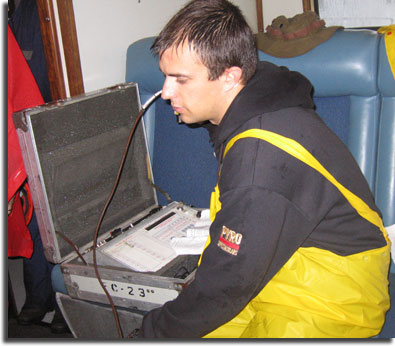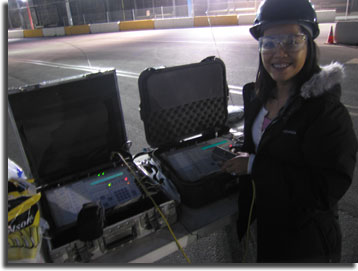 Basic Theory of Operation Basic Theory of Operation
How does the Pyrodigital (PD) system work?
The PD system is essentially a computer used for one task, to shoot fireworks. Since it is dedicated to a single function, it does that single function very well. The system reads an internal data table (your show script), and gives the appropriate address a fire command when the time on the show clock matches a time specified in the data table.
There are only 3 wires in an XLR cable, so how does it command the hundreds, if not thousands of different cues on an individual basis?
The system is issuing a serial data command which all the modules see, not just one module at a time. It is the responsibility of each Field Module (FM) to read the serial data and decide if its own address matches the address just received. If its address matches the one just received, then it reads the particular cue that needs to be fired from the serial data stream and hits it with a firing pulse (a short duration voltage applied to the cue terminal). This is of course an extremely simplified explanation on how the system works, but it should give you the idea.
|
 How do you program when each shot will fire? How do you program when each shot will fire?
This is done through software on a PC long before you start your setup in the field. A show producer will script the show ahead of time, and download it to the FC. Technically, you could program each shot one at a time into the controller by using the keypad on the FC, but this is not really practical for a typical size show due to the amount of time it would take. The keypad and editing functions on the FC are used mainly for making slight modifications to a script such as changing a shot address, shot time, or inserting new shots if necessary. These functions are shown in detail in our section on Using the Field Controller.
How is Pyrodigital's time formatted?
The Pyrodigital system uses hours, minutes, seconds, and frames (00:00:00:00). Hours, minutes, and seconds are self explanatory. There are 30 frames per second (this is standard for video). In other words, each second is divided into 30 segments. So in a script, a particular shot time might be 00:03:21:17, which means that shot will fire at 0 hours, 3 minutes, 21 seconds, and 17 frames on the show clock.
Is shot time and address the only thing needed in a data table?
No. The data table is also created using Pre-Fire Delay (PFD), and Caliber. In reality, shot time is really "Event Time". Event time is the time the "event" will happen. For example, it is the time in which the show producer wanted a 6" shell to break, NOT fire. Having said that, we can now explain PFT. Each shell has a certain "lift" time. Lift time being defined as the time the shell was fired to the time the shell breaks at apogee. So for example, if we know that a particular 6" shell has a lift time of 5.2 seconds, we will program a PFD of 5.2 seconds for that shot. The FC will now shoot that shell 5.2 seconds before its "event time" in the data table.
Caliber is used to identify a certain type, grouping, or position of devices for safety reasons. For a simple example, lets say you have 4", 5", 6", and 10" shells. Each 5" shell is programmed with a Caliber of 5, each 6" shell is programmed with a caliber of 6, so on and so forth. Let's say its 10 minutes to show time and the wind has picked up an additional 7 miles per hour and the fire inspector says, you can't shoot your 10" shells. Are you going to go through and eliminate each 10" shell in your script one at a time? Are you going to run out to the field and unplug each one of your 10" shells? No, you simply use the caliber lockout feature of the FC. By pressing "10" on the Caliber Lockout, you have effectively "unplugged" the 10" shells from the show and they will no longer fire. This feature can also be used during the show if a safety issue arises while you are firing which requires a certain position or grouping of racks to be locked out. Remember, that the Caliber size must be programmed to the shots you wish to lock out before this feature can be used.
Now that you understand the basic theory of operation, you can continue on to the Pyrodigital firing system setup and layout.
|
 Basic Theory of Operation
Basic Theory of Operation How do you program when each shot will fire?
How do you program when each shot will fire?